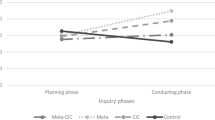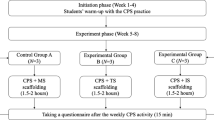Abstract
This article explores the effect of computerized scaffolding with different scaffolds (structuring vs. problematizing) on intra-group metacognitive interaction. In this study, we investigate 4 types of intra-group social metacognitive activities; namely ignored, accepted, shared and co-constructed metacognitive activities in 18 triads (6 control groups; no scaffolds and 12 experimental groups; 6 structuring scaffolds and 6 problematizing scaffolds). We found that groups receiving scaffolding showed significantly more intra-group interactions in which the group members co-construct social metacognitive activities. Groups receiving problematizing scaffolds showed significantly less ignored and more co-constructed social metacognitive interaction compared to groups receiving structuring scaffolds. These findings indicate that scaffolding positively influenced the group members’ intra-group social metacognitive interaction. We also found a significant relation between students’ participation in intra-group social metacognitive interaction and students’ metacognitive knowledge. Twelve percent of the variance in students’ metacognitive knowledge was explained by their participation in intra-group shared social metacognitive interaction. Therefore, future research should consider how to design scaffolds that elicit intra-group social metacognitive interaction among group members to enhance the development of students’ metacognitive knowledge.


Similar content being viewed by others
References
Azevedo, R., & Cromley, J. G. (2004). Does training on self-regulated learning facilitate students’ learning with hypermedia? Journal of Educational Psychology, 96(3), 523–535.
Azevedo, R., Moos, D. C., Greene, J. A., Winters, F. I., & Cromley, J. G. (2008). Why is externally-facilitated regulated learning more effective than self-regulated learning with hypermedia? Educational Technology Research and Development, 56(1), 45–72.
Barron, B. (2000). Achieving coordination in Collaborative Problem-Solving Groups. The Journal of the Learning Sciences, 94(4), 403–436.
Barron, B. (2003). When smart groups fail. The Journal of the Learning Sciences, 12(3), 307–359.
Baylor, A. (1999). Intelligent agents as cognitive tools for education. Educational Technology, 39(2), 36–40.
Chi, M. (2009). Active-constructive-interactive: a conceptual framework for differentiating learning activities. Topics in Cognitive Science, 1(1), 73–105.
Chi, M. T. H., Siler, S., Jeong, H., & Hausmann, R. (2001). Learning from human tutoring. Cognitive Science, 25, 471–534.
Damon, W. (1984). Peer education: the untapped potential. Journal of Applied Developmental Psychology, 5, 331–343.
Davis, E. A., & Linn, M. (2000). Scaffolding students’ knowlegde integration; Prompts for reflection in KIE. International Journal of Science Education, 22(8), 819–837.
Dillenbourg, P. (1999). What do you mean by collaborative learning? In P. Dillenbourg (Ed.), Collaborative-learning: cognitive and computational approaches (pp. 1–19). Oxford: Elsevier.
Doise, W. (1990). The development of individual competencies through social interaction. In H. C. Foot, M. J. Morgan, & R. H. Shute (Eds.), Children helping children (pp. 43–64). New York: Wiley.
Doise, W., & Mugny, G. (1984). The social development of the intellect. Oxford: Pergamon press.
Field, A. (2005). Discovering statistics with SPSS. London: Sage.
Field, A. (2012). Discovering statistics with SPSS. London: Sage.
Flavell, J. H. (1979). Metacognition and cognitive monitoring: a new area of cognitive-developmental inquiry. American Psychologist, 34(10), 906–911.
Fleiss, J. (1981). Statistical itletlzods for rates and proportions. New York: John Wiley and Sons.
Franke, R. H., & Kaul, J. D. (1978). The Hawthorne experiments: first statistical interpretation. American sociological review, 623–643.
Goos, M., Galbraith, P., & Renshaw, P. (2002). Socially mediated metacognition: creating collaborative zones of proximal development in small group problem solving. Educational Studies in Mathematics, 49, 193–223.
Hadwin, A., & Oshige, M. (2011). Self-regulation, co-regulation, and socially shared regulation: Exploring perspectives of social in self-regulated learning theory. Teachers College Record, 113(6)
Hadwin, A.F., Järvelä, S., & Miller, M. (2011). Self-regulated, co-regulated, and socially-shared regulation of learning. In B. J. Zimmerman & D. H. Schunk (Eds.), Handbook of self-regulation of learning and performance (pp. 65–84). New York, NY: Routledge.
Hatano, G. (1993). Time to merge Vygotskian and constructivist conceptions of knowledge acquisition. In E. A. Forman, N. Minick, & C. A. Stone (Eds.), Contexts for learning: Sociocultural dynamics in children’s development (pp. 153–166). New York: Oxford University Press.
Hmelo-Silver, C. E., & Azevedo, R. (2006). Understanding complex systems: some core challenges. The Journal of the Learning Sciences, 15(1), 53–61.
Iiskala, T., Vauras, M., Lehtinen, E., & Salonen, P. (2011). Socially Shared metacognition within primary school pupil dyads’ collaborative processes. Learning and Instruction, 21, 379–393.
Järvelä, S., & Hadwin, A. (2013). New frontiers: regulating learning in CSCL. Educational Psychologist, 48(1), 25–39.
King, A. (1998). Transactive peer tutoring: distributing cognition and metacognition. Educational Psychology Review, 10(1), 57–74.
King, A. (2002). Promoting thinking through peer learning. Theory Into Practice, 41(1), 33–39.
Lin, X., & Sullivan, F. R. (2008). Computer context for supporting metacognitive learning. In J. Voogt & G. Knezek (Eds.), International handbook of information technology in primary and secondary education (Vol. 1, pp. 281–298). New York: Springer.
Liskala, T., Vauras, M., & Lehtinen, E. (2004). Socially-shared metacognition in peer learning? Hellenic Journal of Psychology, 1(2), 147–178.
Meijer, J., Veenman, M. V., & van Hout-Wolters, B. H. (2006). metacognitive activities in text-studying and problem-solving: development of a taxonomy. Educational Research and Evaluation, 12(3), 209–237.
Mercer, N. (1996). The quality of talk in children’s collaborative activity in the classroom. Learning and Instruction, 6, 359–377.
Molenaar, I. (2003). Exploration-net: Online collaboration. In D. Lassner & C. McNaught (Eds.), Proceedings of World Conference on Educational Multimedia, Hypermedia and Telecommunications 2003 (pp. 398–400). Chesapeake, VA: AACE.
Molenaar, I., & Järvelä, S. (2014). Sequential and temporal characteristics of self and social regulated learning. Metacognition and Learning. doi:10.1007/s11409-014-9114-2.
Molenaar, I., & Roda, C. (2008). Attention management for dynamic and adaptive scaffolding. Pragmatics ∓ Cognition, 16(2), 224–271.
Molenaar, I., & Roda, C. (2011). Attention management for dynamic and adaptive scaffolding. In I. E. Droir (Ed.), Technology Enhanced Learning and Cognition (pp. 51–96). Amsterdam/Philadelphia: John Benjamins Publishing Company.
Molenaar, I., Chiu, M. M., Sleegers, P. J. C., & van Boxtel, C. A. M. (2011). Scaffolding of small groups’ metacognitive activities with an avatar. International Journal of Computer Supported Collaborative Learning, 6(4), 601–624.
Molenaar, I., van Boxtel, C. A. M., & Sleegers, P. J. C. (2010). The effects of scaffolding metacognitive activities in small groups. Computers in Human Behavior, 26(6), 1727–1738.
Molenaar, I., van Boxtel, C. A. M. & Sleegers, P. J. C. (2013). Dynamic metacognitive scaffolding in small groups. In R. Azevedo & V. Aleven (Eds.), International Handbook of Metacognition and Learning Technologies (pp. 561–574). New York: Springer Science.
Molenaar, I., van Boxtel, C.A. M., & Sleegers, P. J.C. (2014). Metacognitive scaffolding during collaborative learning: A promising combination. Metacogntion and learning.
Nelson, T. O. (1996). Consciousness and metacognition. American Psychologist, 51, 102–116.
Pea, R. D. (2004). The social and technological dimensions of scaffolding and related theoretical concepts for learning, education and human activity. The Journal of the Learning Sciences, 13(3), 423–451.
Piaget, J. (1932). The language and thought of the child (2nd ed.). London: Routledge and Kegan Paul.
Puntambekar, S., & Hubscher, R. (2005). Tools for scaffolding students in a complex learning environment: what have we gained and what have we missed? Educational Psychologist, 40(1), 1–12.
Rafal, C. (1996). From co-construction to takeovers: science talk in a group of four girls. Journal of Learning Sciences, 5, 279–293.
Reiser, B. J. (2004). Scaffolding complex learning: the mechanisms of structuring and problematizing student work. The Journal of the Learning Sciences, 13(3), 273–304.
Roschelle, J. (1996). Learning by collaborating: Convergent conceptual change. In T. Koschmann (Ed.), CSCL: Theory and practice of an emerging paradigm (pp. 209–248). Mahwah: Erlbaum.
Rosenthal, R. (1991). Meta-analytic procedures for social research (revised). Newbury Park: Sage.
Rummel, N., & Spada, H. (2005). Learning to collaborate: an instructional approach to promoting collaborative problem solving in computer-mediated settings. The Journal of the Learning Sciences, 14(2), 201–241.
Salomon, G. (1993). Distributed cognitions; psychological and educational considerations. Cambridge: Cambridge University Press.
Schoor, C., & Bannert, M. (2012). Exploring regulatory processes during a computer-supported collaborative learning task using process mining. Computers in Human Behavior, 28(4), 1321–1331.
Sharma, P., & Hannafin, M. J. (2007). Scaffolding in technology-enhanced learning environments. Interactive Learning Environments, 15(1), 27–46.
Stahl, G., Koschmann, T., & Suthers, D. (2006). Computer-supported collaborative learning: An historical perspective. In R. K. Sawyer (Ed.), Cambridge handbook of the learning sciences (pp. 409–426). Cambridge: Cambridge University Press.
Strijbos, J., & De Laat, M. (2010). Developing the role concept for computer-supported collaborative learning: an explorative synthesis. Computers in Human Behavior, 26(4), 495–505.
Suthers, D., Dwyer, N., Medina, R., & Vatrapu, R. (2010). A framework for conceptualizing, representing and analyzing distributed interaction. International Journal of Computer Supported Collaborative Learning, 5, 5–42.
Teasley, S. (1997). Talking about reasoning: How important is the peer in peer collaboration? In L. B. Resnick, R. Saljo, C. Pontecorvo, & B. Burge (Eds.), Discourse, tools and reasoning: Essays on situated cognition (pp. 361–384). Berlin: Springer.
Van Boxtel, C. (2004). Studying peer interaction from three perspectives: the example of collaborative concept learning. In J. L. v d Linden & P. Renshaw (Eds.), Dialogic learning: shifting perspectives to learning, instruction and teaching (pp. 125–144). Dordrecht: Kluwer Academic Publishers.
Van de Pol, J., Volman, M., & Beishuizen, J. (2010). Scaffolding in teacher–student interaction: a decade of research. Educational Psychology Review, 22(3), 271–296.
Veenman, M. V. J., Kok, R., & Blote, A. W. (2005). The relation between intellectual and metacognitive skills in early adolescence. Instructional Science, 33(3), 193–211.
Veenman, M. V. J., Van Hout-Wolters, B. H. A. M., & Afflerbach, P. (2006). Metacognition and learning: conceptual and methodological considerations. Metacognition Learning, 1(1), 3–14.
Veldhuis-Diermanse, A. E. (2002). CSCL-Learning? Participation, learning activities and knowledge construction in computer-supported collaborative learning in higher education. University of Wageningen
Volet, S., Vauras, M., & Salonen, P. (2009). Self- and social regulation in learning contexts: an integrative perspective. Educational Psychologist, 44(4), 215–226.
Webb, M. (2009). The teacher's role in promoting collaborative dialogue in the classroom. British Journal of Educational Psychology, 79, 1–28.
Weinberger, A., & Fischer, F. (2006). A framework to analyze argumentative knowledge construction in computer-supported collaborative learning. Computers & Education, 46, 71–95.
Weinberger, A., Stegmann, K., & Fischer, F. (2007). Knowledge convergence in collaborative learning: concepts and assessment. Learning and Instruction, 17(4), 416–426.
Winne, P. H., & Hadwin, A. F. (2010). Self-regulated learning and socio-cognitive theory. In B. McGaw, E. Baker, & P. Peterson (Eds.), International encyclopedia of education (3rd Edition). New York.
Wood, D., Bruner, J., & Ross, G. (1976). The role of tutoring in problem solving. Journal of Child Psychology and Psychiatry, 17, 89–100.
Zimmerman, B. J. (2002). Becoming a self-regulated learner: an overview. Theory Into Practice, 42(2), 64–70.
Author information
Authors and Affiliations
Corresponding author
Appendixes
Appendixes
Appendix 1 Coding Schema
Appendix 2 screenshots


Rights and permissions
About this article
Cite this article
Molenaar, I., Sleegers, P. & van Boxtel, C. Metacognitive scaffolding during collaborative learning: a promising combination. Metacognition Learning 9, 309–332 (2014). https://doi.org/10.1007/s11409-014-9118-y
Received:
Accepted:
Published:
Issue Date:
DOI: https://doi.org/10.1007/s11409-014-9118-y




